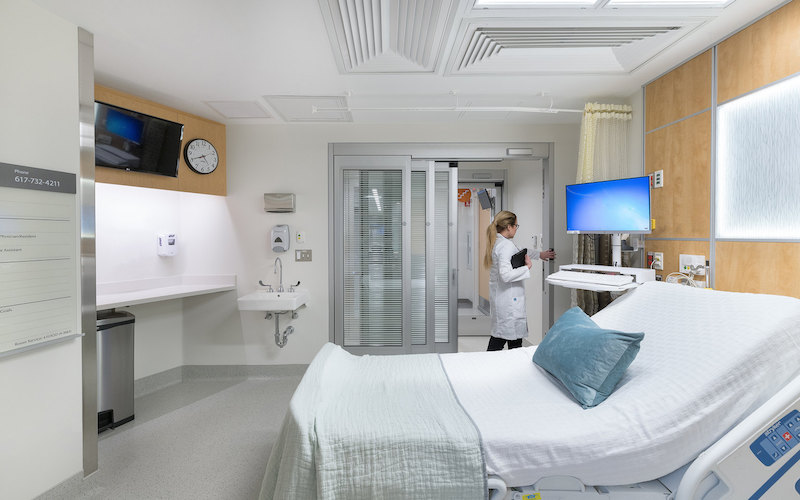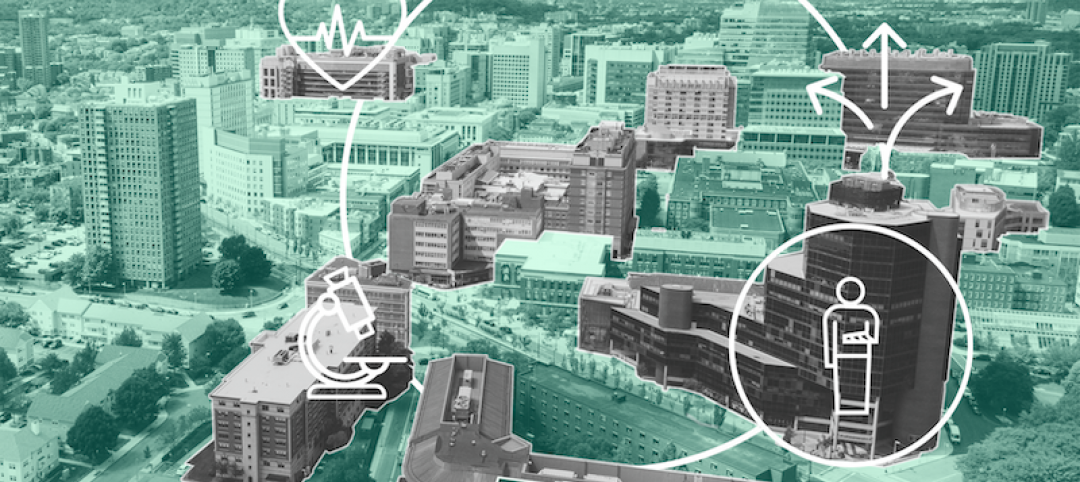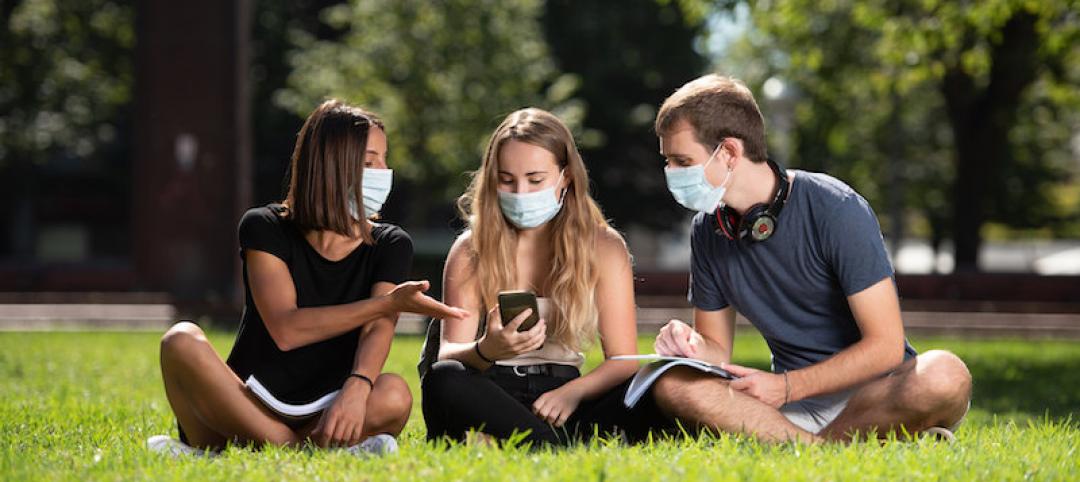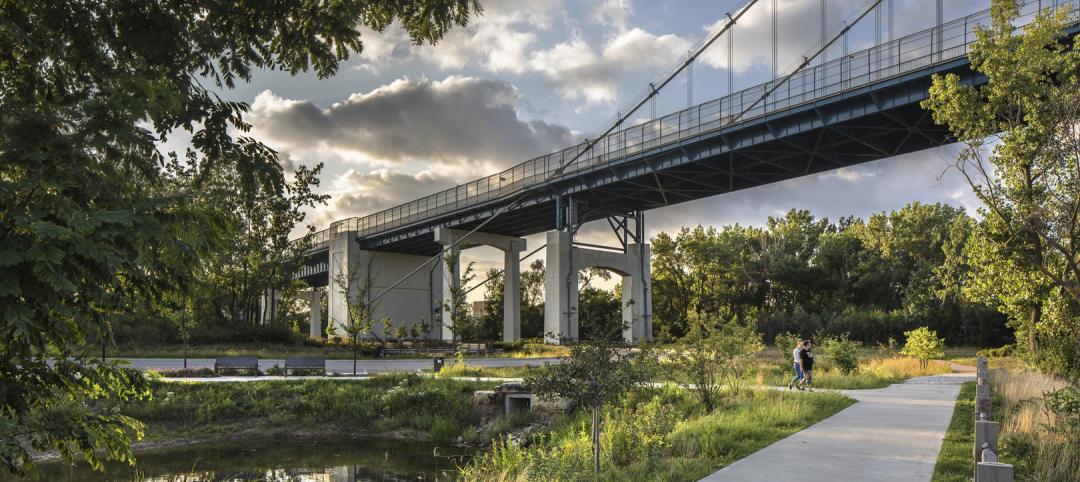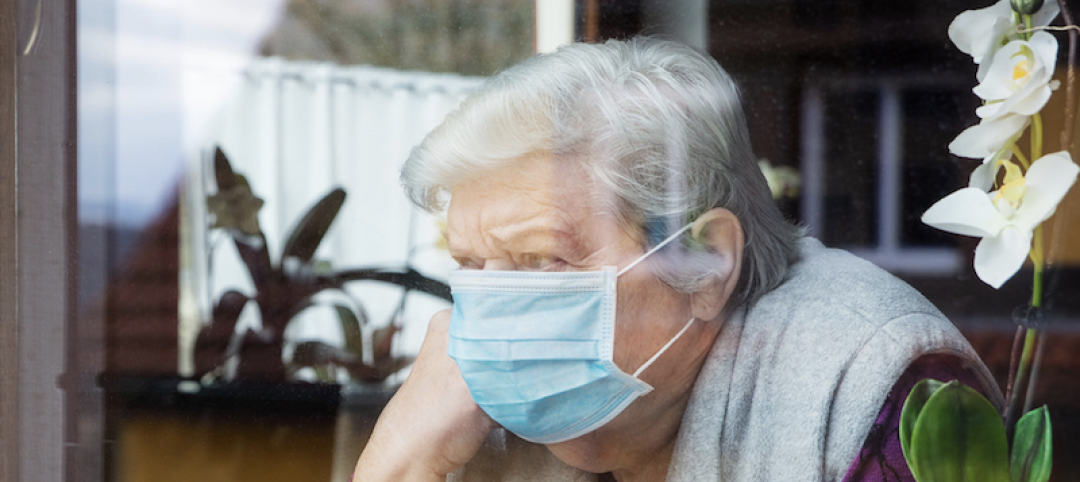Each year, approximately 90,000 Americans die as a result of Healthcare Associated Infections (HAIs)—new bacterial, fungal, and viral infections contracted while receiving treatment. HAIs can occur in any care setting, but the Centers for Disease Control estimates that 722,000 hospital admissions result in HAIs, costing the health industry $28–$33 billion annually. For many health systems, seeking ways to mitigate HAIs and protect their patients is a high priority. Because the physical environment is a major contributor to the spread of infection, facility design has a potentially large impact on HAI prevention and control.
In 2015, the Boston-based Healthcare Associated Infection Organization (HAIO)proposed a challenge to the city’s top healthcare design firms: design the ideal patient room to assist in the reduction of HAIs. The winning team would get to see their prototype room built at an area hospital.
Healthcare staff are one of the most common contributors to the spread of pathogens in the healthcare environment, so the SmithGroup team focused on design interventions that influence human behavior. Through the course of a workday, a healthy member of the medical staff can transfer a pathogen to an immunocompromised patient through soiled hands or equipment. Since correct hand hygiene is so critical to reducing HAIs, SmithGroup’s concept design featured an illuminated sign over the handwashing sink that displays the words “Please wash hands” whenever staff enter the room. We also incorporated carefully-placed designated work surfaces for different patient care tasks to eliminate the potential for cross-contamination. The design used visual cues to divide the room into staff, patient, and family zones to discourage behavior that might contribute to contamination, while the flow of materials and equipment drove the final layout.
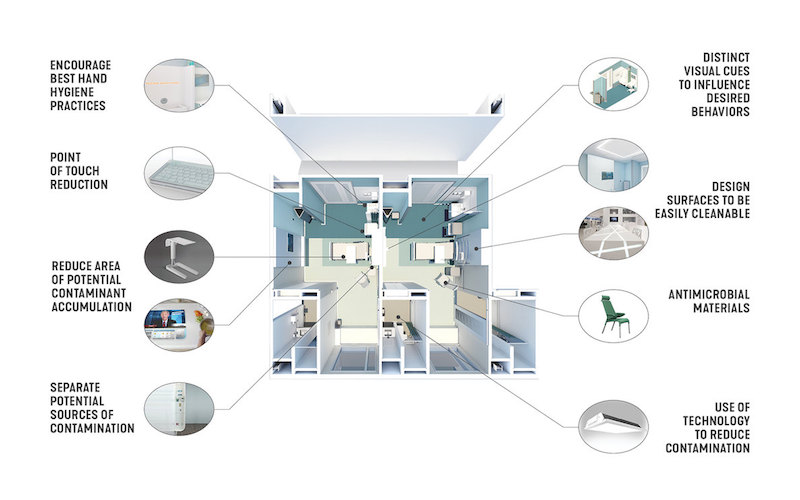 SmithGroup's Smart Patient Room Concept.
SmithGroup's Smart Patient Room Concept.
To mitigate opportunities for pathogen growth, we selected materials that were easy to clean and would not harbor microbes. We designed the room with minimized inside corners and rounded solid surface walls to help reduce the time and effort required to clean the patient room effectively. We also found opportunities to eliminate touch with hands-free technology, such as automatic door openers and faucets, and the removal of high touch surfaces like enclosed cabinetry. SmithGroup’s team of architects, interior designers, engineers and equipment planners worked to make sure everything from air distribution to plumbing and light fixtures to furniture items were all designed to support patient care while creating an easy to clean environment.
A total of seven design firms submitted patient room designs to the HAIO competition, each using innovative technologies and approaches to reduce HAIs. When the committee reviewed the submissions to select a winner, a new vision came into view. Rather than selecting one firm as the winner, it was decided that more would be gained by all of the firms working together with the HAIO committee to validate and select interventions to prototype and test. SmithGroup joined the other competitors as well as representatives from Partner’s Healthcare Real Estate and Facilities, Suffolk Construction and infection control experts at Massachusetts General Hospital, Brigham and Women’s Hospital, and Dana Farber Cancer Institute to form the HAIO Patient Room Challenge Committee. Leveraging these diverse perspectives, the committee began working together to share and validate the best ideas and develop a prototype for the ideal patient room.
A primary goal of the committee was to find an opportunity to test these interventions in a real-world environment. Brigham and Women’s Hospital (BWH) offered the opportunity to build and test the prototype room as part of its upcoming renovation of a 10-bed bone marrow transplant (BMT) unit.
SmithGroup has an ongoing relationship with BWH, completing several similar renovations in the past, and had already been contracted to provide architectural and engineering services for the BMT unit. As the architects and engineers of record, SmithGroup served as the nexus point between the HAIO Committee and the project design. As the Project Architect and Planner for the project, I became intimately involved in the decision making and implementation of the interventions.
While the SmithGroup project team was working with the hospital user groups to design the full renovation, we were simultaneously meeting with the HAIO Committee to refine the interventions for the prototype room. The BMT unit is located in the original bed tower at BWH, built in the late 1970s. The building is designed in a clover-leaf shape with four circular patient units. The rooms radiate around the center core, which contains all of the nursing support. This radial arrangement necessitates small, pie-shaped patient rooms which meet FGI Guidelines for code minimum but are approximately half the size of the typical, best-practice single patient rooms designed today. Fortunately, during previous renovations, SmithGroup had worked through many of the challenges and limitations of planning a modern inpatient unit in this unique bed tower; however, the challenge of incorporating the HAIO interventions was made even more complex by the difficult floor plan.
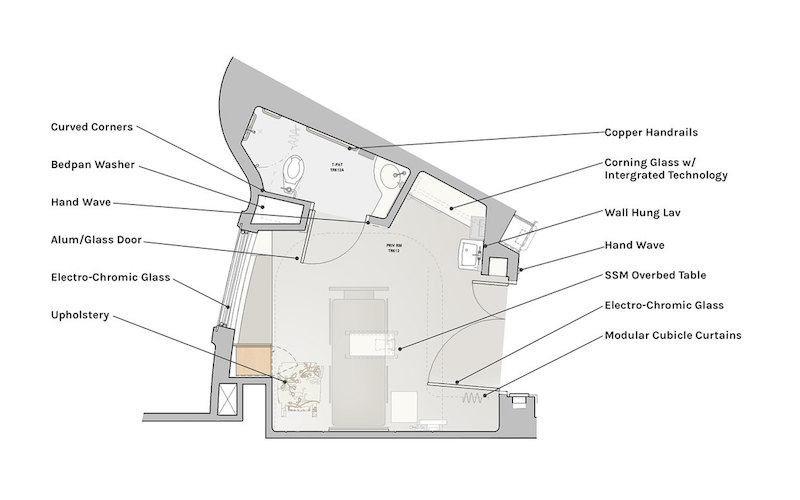 Brigham and Women's Hospital, Bone Marrow Transplant Unit.
Brigham and Women's Hospital, Bone Marrow Transplant Unit.
As the HAIO Committee validated the proposed interventions for efficacy, we had to confirm that they could be accommodated in the tight space. The infection control experts on the committee provided invaluable insight into the different products and solutions. For example, the anti-microbial products that were proposed in the competition by many teams were largely eliminated due to their unsubstantiated impact and potential chemical safety concerns. Many of the technological interventions were also limited in the final design. Because we were only renovating a single unit within an aging building, it was hard to justify the cost, infrastructure, and training required to support certain technologies.
Ultimately, the group had to be very judicious about incorporating only evidence-based design solutions that would have the most impact. The resulting patient room design focused on three primary goals: reducing touch, eliminating difficult to clean spaces, and preventing splash and cross-contamination. To address these goals, we implemented the following design interventions:
— Wave door opener at sliding entrance doors, eliminating the need to touch a handle or button.
— Separating the handwashing sink from work zones to prevent splash and cross-contamination.
— Rounded drywall corners to facilitate more effective cleaning and disinfecting.
— Elimination of dust-collecting shelves and other small spaces that can accumulate and transfer germs.
— Curved solid surface walls in the bathroom to ensure it could be cleaned thoroughly.
Beyond a single prototype, we were able to incorporate many of the design solutions from the HAIO Committee into the final design of all ten rooms in the BMT unit. Many of these solutions, such as the location of the handwashing sink, the use of rounded corners, and the elimination of unnecessary surfaces and small niches, were incorporated without significant impact on project cost. Substantial construction on the BMT unit completed in February 2018 and was opened to patients the following month.
Since many of the proposed interventions were eliminated purely based on the tight footprint and operational constraints, the committee compiled a list of additional items that were deemed effective. While not feasible for this particular build-out, some of the recommended design solutions to reduce HAIs include:
— Self-contained bedpan washing units in each bathroom, reducing potential contamination.
— Integrated TV and technology display behind glass, eliminating touch points and difficult to clean dust-collecting surfaces.
— Visual displays to encourage proper handwashing practices.
— Smooth, seamless high-tech surfaces, such as digital e-glass in place of curtains.
— Staff access to bathrooms from outside the patient room to limit contamination during cleaning.
The HAIO Committee plans to further develop and implement solutions at other Boston area hospitals. The goal is to evolve the prototype with lessons from the interventions that were introduced at BWH, as well as test some of the design interventions that were not feasible in the BMT renovation.
While new construction provides the greatest opportunity and flexibility for improving the built environment’s impact on HAIs, it is possible to incorporate many simple, straightforward interventions in renovations, even in small spaces with limited resources. When a hospital and their design team are focused on designing spaces that are easier to clean and encourage different human behaviors, there is significant potential to reduce HAIs in any patient environment.
Personally, this experience has made me keenly aware of how space planning and detailing can have major impacts on the long-term cleanliness of a space. Having in-depth conversations with infection control experts and a diverse group of healthcare design peers built a much deeper understanding of what is most crucial when designing for patient safety. I now serve as an advocate for what I learned through this experience, teaching my fellow designers at SmithGroup what design moves can be made to reduce HAIs. SmithGroup remains involved in the HAIO Committee as we continue to drive discussions in innovative healthcare design and work to eliminate HAIs in all healthcare environments.
More from Author
SmithGroup | Oct 28, 2024
A case for mid-rise: How multifamily housing can reshape our cities
Often referred to as “five-over-ones,” the mid-rise apartment type is typically comprised of five stories of apartments on top of a concrete “podium” of ground-floor retail. The main criticism of the “five-over-one” is that they are often too predictable.
SmithGroup | Mar 28, 2023
Inclusive design requires relearning how we read space
Pulling from his experience during a campus design workshop, David Johnson, AIA, LEED AP, encourages architects to better understand how to design spaces that are inclusive for everyone.
SmithGroup | Feb 27, 2023
Surfing the Metaversity: The future of online learning?
SmithGroup's tour of the Metaversity gives us insight on bringing together physical and virtual campuses to create a cohesive institution.
SmithGroup | Nov 28, 2022
Data centers are a hot market—don't waste the heat!
SmithGroup's Brian Rener shares a few ways to integrate data centers in mixed-use sites, utilizing waste heat to optimize the energy demands of the buildings.
SmithGroup | Aug 3, 2022
Designing learning environments to support the future of equitable health care
While the shortage of rural health care practitioners was a concern before the COVID-19 pandemic, the public health crisis has highlighted the importance of health equity in the United States and the desperate need for practitioners help meet the needs of patients in vulnerable rural communities.
SmithGroup | Aug 10, 2021
Retail reset: The future of shopping malls
Developers and design partners are coming together to reimagine how malls can create a new generation of mixed-use opportunities.
SmithGroup | May 17, 2021
Future pandemic preparedness at the medical district scale
The current COVID-19 pandemic highlights the concern that we will see more emergency events in the coming years.
SmithGroup | Jan 25, 2021
Amid pandemic, college students value on-campus experience
All the students we interviewed were glad that they returned to campus in one form or another.
SmithGroup | Aug 13, 2020
Renewing the healing role of public parks
While we can’t accurately predict all the ways we will respond to the current COVID-19 pandemic, it should provide a moment of reflection as we see all too clearly the consequences of our exploitation and destruction of nature.
SmithGroup | Jul 21, 2020
How design of senior living communities must change after COVID-19
The cost of maintaining high quality of care and high quality of life for senior living communities has increased up to 73% for senior living communities that remain free of COVID-19 and up to 103% for COVID-19 positive senior living communities.

